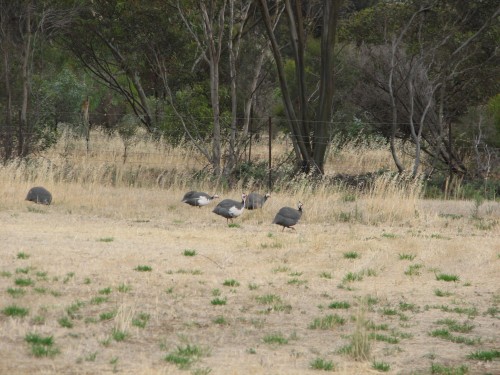Aggressive birds
This morning I was on my way to take my mother-in-law shopping. As I passed the local golf course an Australian Magpie flew low and rapidly across the road in front of my car. Nothing unusual about that.
Hot on its tail, however, was a New Holland Honeyeater, aggressively chasing the much bigger magpie and snapping at its tail feathers.
It always amuses me how some of our smallest birds will actively and quite aggressively harass birds many times their size. Probably the most bizarre example I’ve seen is a Willie Wagtail coming in at about 20 cm (8 inches) attacking our largest bird of prey, the Wedge-tailed Eagle at about 110 cm (44 inches) and a wing span of 280 cm (112 inches).
These little birds know instinctively that the larger birds often prey upon their nests, taking eggs or baby birds. They seem to know no fear as they protect their little ones.
Australia Day 2010
January 26th is celebrated as Australia Day. This day commemorates the landing of the first European settlers in Australia. This event occurred at Sydney Cove on this day in 1788.
Australians celebrate this special day in many ways. Many people new to our country become naturalized Australians in moving ceremonies in many places. Other people attend family gatherings or get together with their friends. Some people go to the beach, others have a picnic or barbecue, and many people attend major sporting events.
I’m having a quiet day at home. I’ll do a little reading, watch the cricket and tennis on television and go for a swim in my swimming pool. Normally I’d go out and do some birding, but it’s reather hot today. Instead I’ll share some bird photos with you.
Helmeted Guineafowl
Over the last 25 years I have observed well over a hundred different species of birds in our garden. I can’t give an exact number because my database is not up to date. I think it’s about 110. Some of the birds I have listed include introduced species (eg House Sparrow).
On at least two occasions in recent weeks we have had a visit from our neighbour’s Helmeted Guineafowl. We often hear them calling when we are out in the garden, but this is the first time we have actually seen them venture into our paddock.
I can’t include this as a species for my garden block list. Being domesticated birds they are not free living, so they can’t be included. In the photo below I managed to fluke taking a Galah in flight.
Helmeted Guineafowl are native to Africa. They eat insects and seeds and nest on the ground. They are large birds which measure from 40-71 cm in length, and weigh 700-1600 g.
Dusky Woodswallows
One of those infrequent visitors to our garden is the Dusky Woodswallow, shown in the photo above. In fact, they more often just fly over head on their way somewhere else and don’t even land in our garden. I still count in on my “Garden List” of birds seen. My rule is: if I can see or hear the bird standing in my garden, I count it. We did have them nesting in a tree in our front scrub, but that was many years ago.
Over the last week I have been working outside in the garden – when the hot, summer weather permitted. On a number of occasions a small flock of a dozen or so Dusky Woodswallows flew overhead, hawking insects for minute or two before gliding off elsewhere. They never seem to hang around for long.
Some of the woodswallow species here in Australia can be quite spectacular when they gather in large flocks. On a few occasions I have seen flocks numbering in the many hundred. Quite a sight.
Related articles:
Rainbow Bee-eaters
Rainbow Bee-eaters would have to be high on my list of my favourite birds. In fact, the whole bee-eater family are quite spectacularly coloured birds. I saw several different species during my visit to Royal Chitwan National Park in Nepal a few years ago.
The Rainbow Bee-eater is the only species present in Australia. We always know that spring is well and truly here when they announce their arrive from over wintering in the northern parts of Australia. In the past they have stayed around our home all summer, even nesting on several occasions.
This year they came through a few months ago and then we didn’t hear or see them until earlier this week. It seems a little early for them to be heading back north again. Perhaps they just came to visit to cheer me up. I’d like to think so.
Further reading:










